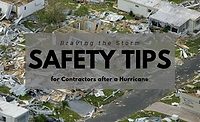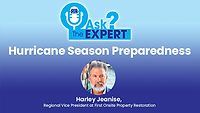“The Calm Before the Storm”: Essential Steps for Hurricane Preparedness
Preparation Tips from Bud Summers

EyeEm Mobile GmbH/iStock / Getty Images Plus via Getty Images
The Atlantic hurricane season officially runs from June 1 to November 30, but the season peaks from mid-August to late October along the U.S. East Coast and in the Eastern Caribbean. Preparation is not just a best practice; it’s essential. A hurricane may only last a few hours, but its aftermath can be devastating, leaving communities stranded for days or even weeks. Here are some critical tips to enhance your preparedness:
- Get Flood Insurance: Regular homeowners' insurance won’t cover flood damage. If you don’t have a flood policy, now is the time to get one.
- Understand Your Risks: Familiarize yourself with your area's flooding risks and local evacuation routes. It’s vital to know if local levees or dams could pose an added threat during severe weather.
- Create an Evacuation Plan: Families and businesses should have clear emergency plans, including communication strategies, evacuation routes, and supplies. Regularly reviewing and practicing these plans can ensure everyone knows what to do when disaster strikes. Don’t forget to plan for pets and those needing extra assistance.
- Secure Important Documents: Store vital documents like birth certificates and proof of property ownership in waterproof bags. If possible, keep devices backed up and in sealed bags as well.
- Take Inventory: In today’s digital age, it’s essential to photograph important documents and securely store them in your device's cloud for added protection. Use your phone to take photos of all four sides of the exterior of your home, and create a video inventory of each room. For big-ticket electronics, take photos of their serial numbers. By taking inventory of your belongings, you ensure that if a catastrophic loss occurs, you have an accurate inventory of your home and valuables.
Fortifying Your Home
Follow the advice of your local authorities on whether you need to evacuate or shelter in place. Regardless of your plans, ensuring your home is secured prior to hurricane season is paramount. Before hurricane season begins, inspect your property for loose shingles, gaps in windows, or cracks in the foundation. Installing storm shutters and reinforcing doors is critically important. Trim any trees that could potentially damage your home during strong winds. PuroClean offers pre- and post-hurricane support and can assist in not only restoring your property after storms but also help you protect your property before the storm makes landfall.
Emergency Preparedness Kits
An emergency kit is essential and should be ready for the storm’s duration. Include water and non-perishable food for at least three days, a battery-powered radio, a flashlight with extra batteries, a first aid kit, and vital documents like marriage certificates and wills. If you have pets, include food, first aid supplies, and any of their essential items in your kit as well.
When a storm approaches, make a decisive choice between staying and evacuating. Ignoring evacuation warnings from local authorities is the worst possible thing you can do. If you are told to evacuate, do not wait too long, as roads will become overly crowded with masses evacuating at once.
If Sheltering in Place:
- Use sandbags or heavy-duty garbage bags filled with water to create a barrier against flooding.
- Charge your phone and any backup batteries you have.
- Set your refrigerator to the coldest setting to preserve food during power outages.
If Evacuating:
- Ensure your vehicle is in good condition, fill the gas tank, and stock emergency supplies, including additional gas to reach your destination, as gas stations along your route may be overwhelmed by people evacuating or you may run out of gas.
- Stay updated with the latest weather and evacuation orders. Follow official routes and avoid shortcuts.
Effective preparation can significantly reduce risks and damages. Stay informed, act early, and take these precautions seriously.
Looking for a reprint of this article?
From high-res PDFs to custom plaques, order your copy today!







